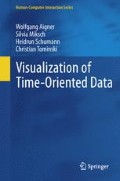Abstract
This chapter sheds some light on analytical methods to support the analysis of time-oriented data. A general overview of temporal data analysis is provided and specific application examples will be used for demonstration.
Access this chapter
Tax calculation will be finalised at checkout
Purchases are for personal use only
Preview
Unable to display preview. Download preview PDF.
References
Antunes, C. M. and Oliveira, A. L. (2001). Temporal Data Mining: An Overview. Workshop on Temporal Data Mining at the ACM SIGKDD International Conference on Knowledge Discovery and Data Mining (KDD).
Bade, R., Schlechtweg, S., and Miksch, S. (2004). Connecting Time-oriented Data and Information to a Coherent Interactive Visualization. In Proceedings of the SIGCHI Conference on Human Factors in Computing Systems (CHI), pages 105–112, New York, NY, USA. ACM Press.
Brockwell, P. J. and Davis, R. A. (2009). Time Series: Theory and Methods. Springer, New York, USA, 2nd edition.
Clancey, W. J. (1985). Heuristic Classification. Artificial Intelligence, 27(3):289–350.
Combi, C., Keravnou-Papailiou, E., and Shahar, Y. (2010). Temporal Information Systems in Medicine. Springer, Berlin, Germany.
Fayyad, U., Grinstein, G. G., and Wierse, A. (2001). Information Visualization in Data Mining and Knowledge Discovery. Morgan Kaufmann, San Francisco, CA, USA.
Fayyad, U., Piatetsky-Shapiro, G., and Smyth, P. (1996). From Data Mining to Knowledge Discovery in Databases. AI Magazine, 17(3):37–54.
Gan, G., Ma, C., and Wu, J. (2007). Data Clustering: Theory, Algorithms, and Applications, ASA-SIAM Series on Statistics and Applied Probability. SIAM, Philadelphia, PA, USA.
Han, J. and Kamber, M. (2005). Data Mining: Concepts and Techniques. Morgan Kaufmann, San Francisco, CA, USA.
Hsu, W., Lee, M. L., and Wang, J. (2008). Temporal and Spatio-Temporal Data Mining. IGI Global, Hershey, PA, USA.
Jackson, J. E. (2003). A User’s Guide to Principal Components, Wiley Series in Probability and Statistics. John Wiley & Sons, Inc., New York, NY, USA.
Jain, A. K., Murty, M. N., and Flynn, P. J. (1999). Data Clustering: A Review. ACM Computing Surveys, 31:264–323.
Jeong, D. H., Ziemkiewicz, C., Fisher, B., Ribarsky, W., and Chang, R. (2009). iPCA: An Interactive System for PCA-based Visual Analytics. Computer Graphics Forum, 28(3):767–774.
Jolliffe, I. T. (2002). Principal Component Analysis, Springer Series in Statistics. Springer, New York, NY, USA, 2nd edition.
Keim, D., Kohlhammer, J., Ellis, G., and Mansmann, F., editors (2010). Mastering the Information Age – Solving Problems with Visual Analytics. Eurographics Association, Geneve, Switzerland.
Keim, D. A., Mansmann, F., Schneidewind, J., and Ziegler, H. (2006). Challenges in Visual Data Analysis. In Proceedings of the International Conference Information Visualisation (IV), pages 9–16, Los Alamitos, CA, USA. IEEE Computer Society.
Laxman, S. and Sastry, P. (2006). A Survey of Temporal Data Mining. Sādhanā, 31:173–198.
Lin, J., Keogh, E. J., Wei, L., and Lonardi, S. (2007). Experiencing SAX: A Novel Symbolic Representation of Time Series. Data Mining and Knowledge Discovery, 15(2):107–144.
Miksch, S., Horn, W., Popow, C., and Paky, F. (1996). Utilizing Temporal Data Abstraction for Data Validation and Therapy Planning for Artificially Ventilated Newborn Infants. Artificial Intelligence in Medicine, 8(6):543–576.
Miksch, S., Seyfang, A., Horn, W., and Popow, C. (1999). Abstracting Steady Qualitative Descriptions over Time from Noisy, High-Frequency Data. In Proceedings of the Joint European Conference on Artificial Intelligence in Medicine and Medical Decision Making (AIMDM), pages 281–290, Berlin, Germany. Springer.
Mitsa, T. (2010). Temporal Data Mining. Chapman & Hall/CRC Data Mining and Knowledge Discovery Series, Boca Raton, FL, USA.
Nocke, T., Schumann, H., and Böhm, U. (2004). Methods for the Visualization of Clustered Climate Data. Computational Statistics, 19(1):75–94.
Shneiderman, B. (1996). The Eyes Have It: A Task by Data Type Taxonomy for Information Visualizations. In Proceedings of the IEEE Symposium on Visual Languages, pages 336–343, Los Alamitos, CA, USA. IEEE Computer Society.
Stacey, M. and McGregor, C. (2007). Temporal Abstraction in Intelligent Clinical Data Analysis: A Survey. Artificial Intelligence in Medicine, 39(1):1–24.
Thomas, J. J. and Cook, K. A. (2005). Illuminating the Path: The Research and Development Agenda for Visual Analytics. IEEE Computer Society, Los Alamitos, CA, USA.
Van Wijk, J. J. and Van Selow, E. R. (1999). Cluster and Calendar Based Visualization of Time Series Data. In Proceedings of the IEEE Symposium on Information Visualization (InfoVis), pages 4–9, Los Alamitos, CA, USA. IEEE Computer Society.
Ware, C. (2008). Visual Thinking for Design. Morgan Kaufmann, Burlington, MA, USA.
Wegner, P. (1997). Why Interaction Is More Powerful Than Algorithms. Communications of the ACM, 40(5):80–91.
Xu, R. and Wunsch II, D. C. (2009). Clustering. John Wiley & Sons, Inc., Hoboken, NJ, USA.
Author information
Authors and Affiliations
Rights and permissions
Copyright information
© 2011 Springer-Verlag London Limited
About this chapter
Cite this chapter
Aigner, W., Miksch, S., Schumann, H., Tominski, C. (2011). Analytical Support. In: Visualization of Time-Oriented Data. Human-Computer Interaction Series. Springer, London. https://doi.org/10.1007/978-0-85729-079-3_6
Download citation
DOI: https://doi.org/10.1007/978-0-85729-079-3_6
Publisher Name: Springer, London
Print ISBN: 978-0-85729-078-6
Online ISBN: 978-0-85729-079-3
eBook Packages: Computer ScienceComputer Science (R0)

